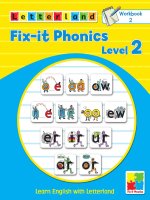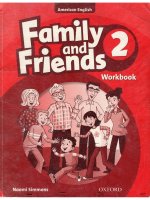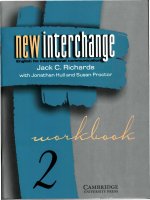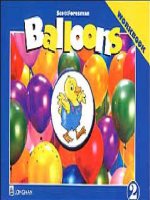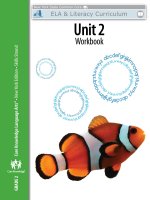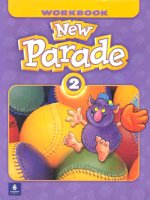Impact 2 workbook
Bạn đang xem bản rút gọn của tài liệu. Xem và tải ngay bản đầy đủ của tài liệu tại đây (10 MB, 98 trang )
AES À4 4444 44
2¬» 2>» >2
`.
S2220 2 214 oe SS
» ` KK
5o XV
OY KO NZ
NATIONAL ^È% CENGAGE
GEOGRAPHIC
LEARNING «© ` Learning
Impact Workbook 2 © 2017 National Geographic Learning, a part of Cengage Learning
Series Editors: JoAnn
and Joan Kang Shin (Jodi) Crandall ALL RIGHTS RESERVED. No part of this work covered by the copyright herein
Publisher: Gavin McLean may be reproduced or distributed in any form or by any means, except as
Commissioning Editor: Sian Mavor
Editorial Manager: Claire Merchant permitted by U.S. copyright law, without the prior written permission of the
Editor: Louisa Essenhigh copyright owner.
Media Research: Leila Hishmeh
Sr. Director, Production: Michael Burggren “National Geographic”, "National Geographic Society" and the Yellow Border
Production Manager: Daisy Sosa Design are registered trademarks of the National Geographic Society
Content Project Manager: Beth McNally ® Marcas Registradas
Manufacturing Manager: Eyvett Davis
Art Director/Cover Design: Brenda Carmichael For product information and technology assistance, contact us at
Interior Design & Composition: Doublelnk Learning Customer & Sales Support at Cengage.com/contact
Audio Producer: James Richardson
For permission to use material from this text or product,
submit all requests online at cengage.com/permissions
Further permissions questions can be emailed to
Workbook with Audio CD Level 2
ISBN: 978-1-337-29393-8
National Geographic Learning
Cheriton House, North Way, Andover, Hampshire, SP10 5BE, United Kingdom
Cengage Learning is a leading provider of customized learning solutions
with office locations around the globe, including Singapore, the United
Kingdom, Australia, Mexico, Brazil, and Japan. Locate your local office at
international.cengage.com/region
[ON THE COVER . bbỒỀỒỀ 7 Cengage Learning products are represented in Canada by Nelson Education, Ltd.
After a summer storm washes away the Visit National Geographic Learning online at NGL.Cengage.com
everyday grime, the true colour of the city Visit our corporate website at www.cengage.com
shines through. Taken at Causeway Bay, one of
the busiest shopping districts in Hong Kong.
IMPACT STUDENT RESOURCES (including audio)
Go to: NGL.Cengage.com/impact2BR
Printed in China by RR Donnelley
Print Number: 01 Print Year: 2016
SERIES EDITORS 2 WORKBOOK
JoAnn (Jodi) Crandall
Joan Kang Shin
Unit 1 Colour Matters 2
Unit 2
Feeling Good? IZ
Unit 3
Unit 4 Units 1-2 Review 22
Unit 5 Your Virtual Self 24
Unit 6
Underwater Mysteries 34
Unit 7
Unit 8 Units 3-4 Review 44
Life in the Extreme 46
Are You Going to Eat That? 56
Units 5-6 Review 66
Art in the Open 68
Don’t Panic! 78
Units 7-8 Review 88
Choice Activities 90
NATIONAL ove CENGA: GE
Lè GEOGRAPHIC ôâ Learning
LEARNING
Australia s Brazil s Mexico « Singapore * United Kingdom » United States
Unit1
Colour Matters
đà Complete the sentences. Then fill in the puzzle.
Across represent them.
1. Many businesses use the colour blue to
2. The colour green often symbolises
3. In many countries, people think the colour red is
4. colours often make us feel happy.
5. Blue jeans are coloured with indigo
'EIEIFIE|IE|S|EINỊT
Down dresses are red.
6. In some countries,
7. Red and yellow are used to people of danger.
8. When we
9. Violetis a someone, we often feel safe with them.
10. purple colour.
vehicles are often red.
đà Match the word to its definition. Write the letter on the line.
_____ 1. warn a. to give information or a warning
__ 2. signal b. to believe in someone or something
___ 3. good luck c. to say that danger is coming
___ 4. ‘trust d. something good that happens
& Listen. Circle T for True or F for False. AGH
kK fF F 4. T F
a T E 5, T F
3. T F 6. T F
Q Listen again. Correct the false statements.
6 Look at the photos. Choose two and write a sentence about them. Use a word from the
box in each sentence.
signal represent danger flag luxury colour-blind warn
A car like this is a luxury.
GRAMMAR
Adjective | ~ Comparative— Superlative
| Green is a common colour. | Red is more common than| Blue is the most common
| purple. colour. |
_ Fuchsia is a bright pink | Hot pink is brighter than Magenta is the brightest
| colour. | fuchsia. colour.
| Fish that live deep inthesea Bats have worse eyesight Moles have the worst
| than deep-sea fish do. | eyesight.
| have bad eyesight.
LL eat
We use comparatives to compare two things. Use more before adjectives that have two or more
syllables. Add -er to adjectives that have just one syllable. With two-syllable adjectives that end
in y, both options are possible (tastier or more tasty). Remember to change y to i.
With a group of three or more things, we use superlatives to compare one thing in the group
to the rest. Superlatives always take the. Use most before adjectives that have two or more
syllables. Add -est to adjectives that have just one syllable. With two-syllable adjectives that
end in y, both options are possible (the tastiest or the most tasty). Remember to change y to i.
Some adjectives are irregular: good/better/best and bad/worse/worst.
đà Listen. Write the letter C when you hear a comparative and the letter S when you hear a
superlative. MZ
1 C
tấu
3.
Listen again. Re-write the comparatives as superlatives and the superlatives as
comparatives. I8
1. the best 4.
2. 5
3, 6
© Fill in the blanks. Use the adjective, the comparative or the superlative form of the words
from the box.
bright common depressed light
nervous ordinary relaxed strong
1. Brighter colours often get reactions than
lighter ones. dark colours.
2. Light colours make us feel is red.
3. That’s why pale yellow and pink are
colours.
black in schools and hospitals. red.
4. Dark colours tend to make people feel
5. The colour that makes people
6. Orange is one of the
7. Pink is a colour that is
8. Aroom without colour looks very
@) Write. Choose at least two colours you really like. Write four sentences comparing the
colours and how you feel about them. Use either a comparative or superlative in each
sentence.
ee Listen and read. As you read, think about the order of events. MGW
Colour, Colour, Colour!
‘Colour, colour, colour!’ are the words of artist and illustrator Eric Carle. Eric is like
royalty in the world of children’s books. He has written over 70 children’s books. His most
famous book, The Very Hungry Caterpillar, is common on children’s bookshelves all over
the world. What most people don’t know is that Eric makes art for adults, too. A lot of people
do not know about Eric’s ‘ArtArt’. ‘ArtArt’ is what Eric’s work for adults is called. People
didn’t know about it, because he didn’t show it to the public until he was 84 years old!
Like Eric’s children’s books, his ‘ArtArt’ is full of bright, vibrant colours. He says that he
loves colour so much because he missed it during the war in Germany.
Eric was born in Syracuse, New York, in 1929, but moved to Germany
with his family when he was six. When he was 10, World War II began.
He noticed that all the houses and buildings in his town were painted
grey, brown or dark green. It was a sad time, and it seemed like there
was no colour anywhere.
At the end of the war, ‘when colour came back’, Eric explains, ‘I
just loved it so much. I keep saying that I wish our eyes could see more
colour. Colour is a very important part of my work.’
Anyone who has seen Eric’s books can see how important colour
is to the artist. He paints bright colours on paper, cuts out shapes,
and then glues them onto another piece of paper. This is no ordinary
method - it is called collage. In fact, this method is what led Eric to his
‘ArtArt’. He never planned on making art for adults, but when he saw
all the extra pieces of colourful paper he had from cutting out shapes, he decided to make
something out of them.
Eric’s ‘ArtArt’ includes large collages as well as paintings, sculptures, photographs and
even costumes. In all these works, he uses a rainbow of colours - everything from purple
to light green to orange. Now that’s a lot of colour!
@ Read. Then tick T for True or F for False. Correct the false statements. LIU u Usa
LI LI L] LIm
1. Eric has created many books for adults.
2. Most people know Eric’s ‘ArtArt’.
3. Collage is a method of gluing coloured pieces of paper together.
4. The colours used during the war represent sadness for Eric.
Œ@ Read ‘Colour, Colour, Colour!’ again. Use the events below to fill in the order of events
and when they happened.
moved-to-Germany showed ‘ArtArt’ to public born
‘colour came back’ World War Il began
bore _ | | 1929
moved to Germany age ©
© Write. You have read about the history of purple and the artist Eric Carle. What is similar
about William Perkin’s and Eric Carle’s experiences while doing their work?
GRAMMAR things
The: Identifying general and specific
The human eye can see over 10 million
My friend started a new company. colours.
The company is called Colour Works.
The moon is glowing orange tonight. Can you pass me the green crayon?
We use the definite article the to refer to a specific noun. The noun is specific because
- it was mentioned before or it is known. : there is only one.
we're referring to it in general. - WeTe providing information that makes it
specific.
Use the indefinite article a/an to refer to something for the first time (/ bought a bright pink pen.) or
to refer to something that is not specific. (Do you have a colourful dress for the party?) You can’t
use a/an with plural nouns.
eB Read. Circle the correct word.
1. The / A back wall of this art room is neon pink.
2. What’s the / a name of this dark blue colour?
3. Our classroom has a / the colourful work station.
4. The / A moon is very bright in the night sky.
5. [bought a / the new pair of shoes. The / A colour of these shoes is light green.
6. Lucy wore an / the orange and green scarf. I didn’t know she had one.
7. In some countries, seeing the / a black cat is good luck.
© Fill in the blanks. Use the or a/an.
1. The sign said to slow down, but Juan did not notice __——s warning.
2. Walking on green grassis — — luxury for Linda because she lives in the desert.
3. Andiwantstostart__—s online company that sells fabric dyes.
4. ______ wedding will be next Saturday afternoon. Ana is so nervous!
5. Have you ever seen violet cloudsin _ sky?
6. French flag on the capitol building is very large.
đà Read Suki and Jake’s blog. Write your comments and advice. Make sure you use the
and a/an in your response.
}
Welcome to our blog! Some of you may have noticed that we want to
repaint the school’s art room. Mr Lee says he trusts us and gives the students
full control. Jake and I started a committee. As leaders of the committee, we
are nervous. We will make the final decision, but want to hear from the whole
student body.
So far, some of the students say they like the room as it is. They like
the bright colours and the fun photographs. But many others say we needa
new look.
A common idea among several students is to paint a mural. Everyone can
help. The question is, ‘What will the mural be?’ Another suggestion is that
students enter design ideas into a contest. The winner will design the large
side wall. And the runner-up will decorate the smaller front and back walls.
So, what will we do? Leave the art room as it is? Paint a mural? Create a
contest in which the winners design the walls? Or something else?
Sam
| like the mural idea. It could be of the school flag!
ki Lucy
| agree that the art room needs a new look. | think the contest is a good idea.
WRITING
A topic sentence introduces the main idea of a paragraph. It says what the paragraph is going
to be about. It also makes readers want to know more. The topic sentence is usually the first
sentence of the paragraph, but it does not always have to be. It explains:
° what you want to say ° why you are writing
Look at these examples of topic sentences:
In this article, I'm going to discuss the history of the colour orange.
When taking a photograph, it’s important to think about light and colour.
Each of the colours and shapes of the South Korean flag represents something specific.
Many people who are colour-blind cannot tell the difference between red and green.
ey Organise.
1. Your topic is Colour Matters. Look through Unit 1 in your book to get some ideas about
what colours you like, what connections you have to them, and how they make you feel.
2. Now fill in the idea map about the colour you chose to write about. Include the colour,
your connection to it, and how it makes you feel.
/⁄ Connections * How I Feel
| \| __( Colour \- f
|| ÀA————Sở |
m .
KY KS
2. Plan your writing. You'll need to begin with a topic sentence. It should state your main
idea, why you are writing and what you want to say. Write your topic sentence here.
Then, you will write a few sentences about your connection to the colour. Finally, you will
write a sentence or two about how the colour makes you feel.
es Write.
1. Go to page 21 in your book. Re-read the model and writing prompt.
2. Write your first draft. Check for organisation, content, punctuation, capitalisation and
spelling.
3. Check your final draft. Share it with your teacher and classmates.
10
Now I can... 0 Yes, | can!
- talk about colours and why they are important. OO I thinkI can.
Give an example of a colour and what people usually associate it with.
C1 Ineed more practice.
Write a sentence that describes how colour can make you feel.
‘use comparatives and superlatives to compare two or more things. O Yes, | can!
Write a sentence with a comparative about two colours or things.
0 I thiInckan.
Cl bheed more practice:
Write a sentence with a superlative about how one colour or thing is the most, the best,
and so on.
- use the to identify general and specific things. O Yes, | can!
, L] I think I can.
Fill in the blanks with the and a/an. C1 I need more practice.
Sara bought interesting painting. My favourite part of painting is sun.
The artist used colour orange instead of yellow. It creates happy feeling.
- write a paragraph about my favourite colour. C1 Yes, | can!
Write a topic sentence about another colour you like. The topic sentence 0 I think | can.
should include why you are writing and what you want to say. 1} | peed more practice.
YOUDEaDS Choose an activity. Go to page 90.
41
Unit 2
Feeling Good?
3 Unscramble the words. Then write the letters in the circles to answer the question below.
ISRVSEU ` t
DAINVE sg
- ý
MIENMU MESTYS —_
SINNOFECTI \ ;
“ RATET i;
TPOTECR
GISETD ; :
oo
`.
ROES ©
TOCANITIBIS |
MYPSTSOM
How can you protect yourself from viruses?
đà Match the word to its definition. Write the letter on the line.
___l. bacteria a. medicine that treats illnesses
_— _ 2. viruses b. one-cell organisms that can be good for the body
___ 3. antibiotic c. the body’s defense against illness
____ 4. immune system d. signs of illness
____ 5. symptoms e. tiny organisms that need a host to survive
12
@ Fill in the blanks. Complete each sentence with a word from the box.
antibiotics bacteria digest disease emotions
positive survive vaccinations viruses
1. When people feel ill and weak, they may be fighting a
2. Illnesses are caused by and
3. One way to protect against viruses is to get
4, Viruses cannot be treated with
5. Bacteria are cells that can inside and outside of the body.
6. Bacteria help us food and feel our
7. It’s important to stay when we are ill.
© Listen. Circle the vocabulary word you hear being described.
vaccinations sore symptoms
cells invade emotions
viruses protect bacteria
infections illnesses
immune system treat positive
antibiotics
6 Listen. Answer each question. You may look at the words from the lists above to help you.
ayes
1, Some symptoms of a cold are a sore throat and sneezing.
2.
3.
13
GRAMMAR
Adverbs: Saying how and how often you do something
| Max often øoes to bed after midnight. resi Suen aed
| Often, Max goes to bed after midnight. |
rere tale nh
He is always tired.
Kara sometimes wakes up before 7.00. | Sometimes, Kara wakes up before 7.00.
She sleeps well.
Caroline occasionally goes to bed by 9.00. } Occasionally, Caroline goes to bed by 9.00. |
i
| She always likes to be rested because she handles problems better.
Some adverbs answer the question ‘How often?’ They usually go in front of the verb. (He always
sleeps late.) Note that these adverbs follow the verb to be. (He is always at home.) Some
adverbs answer the question How? They usually go after the verb. (She sleeps well.)
@ Listen. Write the adverb you hear. Then tick whether it describes ‘How?’ or ‘How often?’
You will hear each sentence twice. ML
`... _ How 0ften
well ⁄
14
đồ Complete the sentences. Put the adverbs in the correct place.
1. If we sleep , we'll stay healthier. (enough)
Be , most/Most mammals need a good night’s
sleep. (usually)
3. Some people get a good night’s sleep. (rarely)
4. , some/Some people fall asleep more than
others. (easily)
5. When we sleep , we can get ill. (poorly)
6. When we sleep , we can think clearly. (well)
7. Humans sleep in beds, but chimpanzees sleep
in trees. (usually)
8. Chimpanzees select trees that look
comfortable. (carefully)
& Put the words in the correct order to form sentences.
1. positively / we / think/ sleep / we / well / when
2. ill / enough / we / don’t / when / sleep / get / we / can / easily / more
3. than /1/ hours / sleep / more / for / rarely/ seven
4. for / sleep / 1 / sometimes / hours / ten
15
@ Listen and read. As you read, think about the main idea of each paragraph. BG
The BenefitS of Playing 4
Imagine that somebody told you to play more video games. Would you
wonder why? Well, believe it or not, video games can be good for you. Can you
believe it? We often hear that video games are bad for you. But research now
shows that video games can positively affect the adolescent brain.
? Studies show that when you play video games, your brain works faster.
You also pay more attention and remember things better. These games can
also help you make decisions and solve problems more quickly and easily.
3 Another benefit of video games is that it can improve eyesight. Studies
show that people who don’t normally play video games improve their eyesight
after a period of time playing them. In fact, doctors use video games to treat
vision problems. For example, some people have one healthy eye and another
that is not as strong. To strengthen the weak eye, people play video games and
cover up the stronger eye.
* Video games can even lower stress and help adolescents with their
emotions. Researchers say that video games with different social scenes
provide young people with real-world emotional experiences. For example,
players can feel excited about doing well or feel disappointed if things don’t go
their way. Players get to practise their emotions, so they are more prepared to
handle them in the real world.
° Finally, video games can prepare adolescents for jobs. For example,
young people who play video games often have strong technology skills. These
skills will be more and more important as our world continues to become
more and more technical and digitised.
16
đô Read. Then tick T for ïrue or F for False. Re-write the false statements to make them true.
T LJ] LJ LI Lin
1. We often hear about the bad effects ofvideo games. LÌ
2. Video games can treat infections. L|
3. Players don’t experience real-world emotions when they play video games. LÌ
4. Video games can help you make decisions quickly. L|
@ Read ‘The Benefits of Playing Video Games’ again. Fill in the table with the main idea of
each paragraph.
, [ Paragraph | ˆ Ss
1 Video games can have positive effects.
© Write. You have read about how the activities you do can affect your brain and overall health.
Keep your readings in mind and answer these questions.
1. Apart from playing video games, name an activity that you spend a lot of time doing.
2. What skills do you use for this activity?
3. How might this activity help you in the future?
17
GRAMMAR
Make + adjective: Saying what affects mood and feelings
Subject | Make | Object (feel) | Adjective
Some viruses
A positive experience make you feel | ill.
Video games | makes you feel | happy.
Exams
can make | a person feel | relaxed.
make | some students | feel _| stressed.
We use make + adjective to describe how a person feels as a result of something. The subject is
the cause or the reason why a person feels a certain way.
@& Complete the sentences. Use the correct form of make.
1. Eating well me healthy.
2. Viruses people ill.
3. Antibiotics can you feel better.
A. It me nervous when I get a vaccination.
5. Video games people focused.
6. Taking a test can you nervous.
@ Listen. Complete the answer to each question. Use make or makes + an adjective from the
word bank.
depressed excited happy hungry nervous sad sleepy stressed
1. They
2. Itcan
3. The doctor
A. Feeling ill
5. Video games
18

